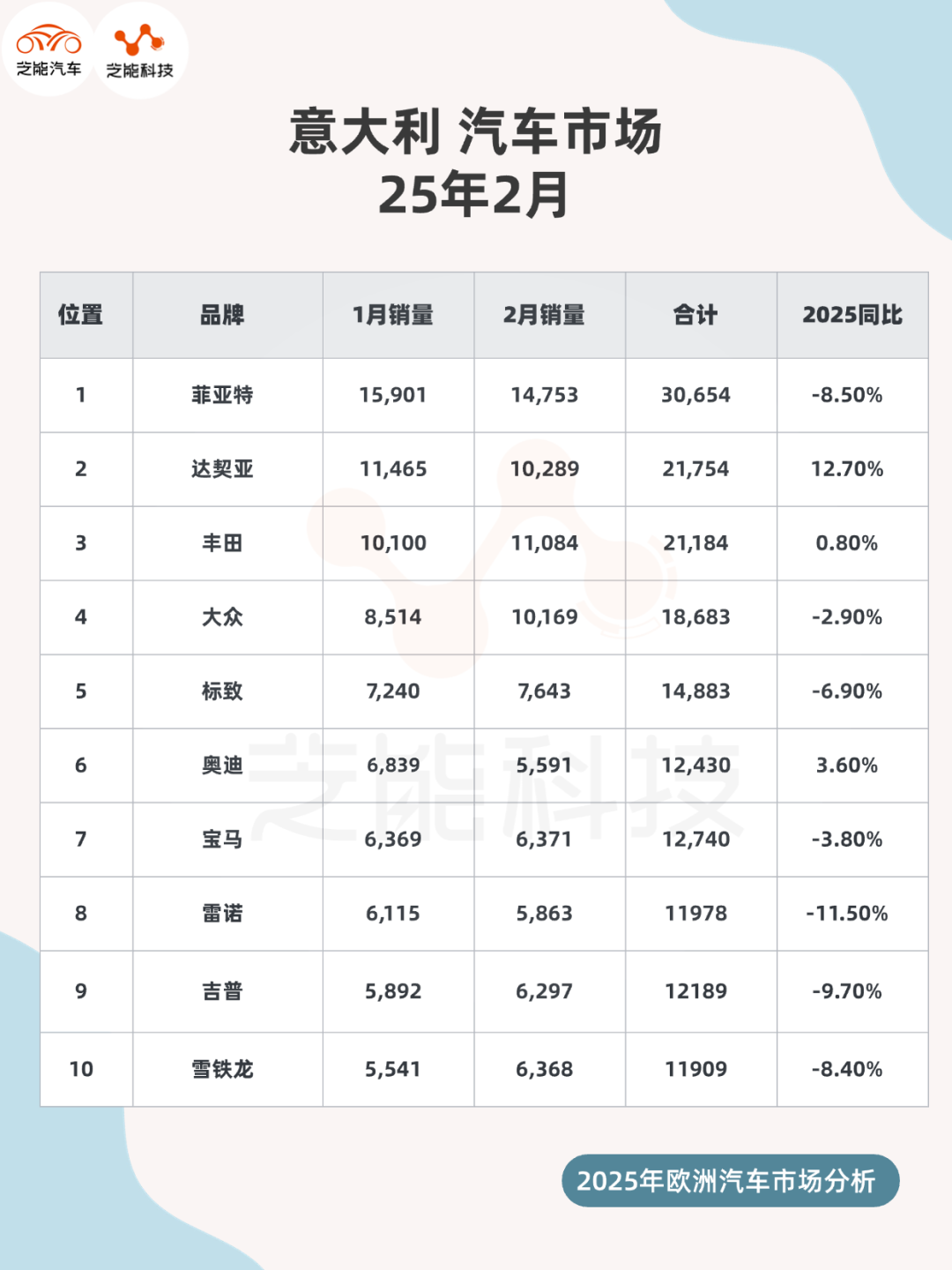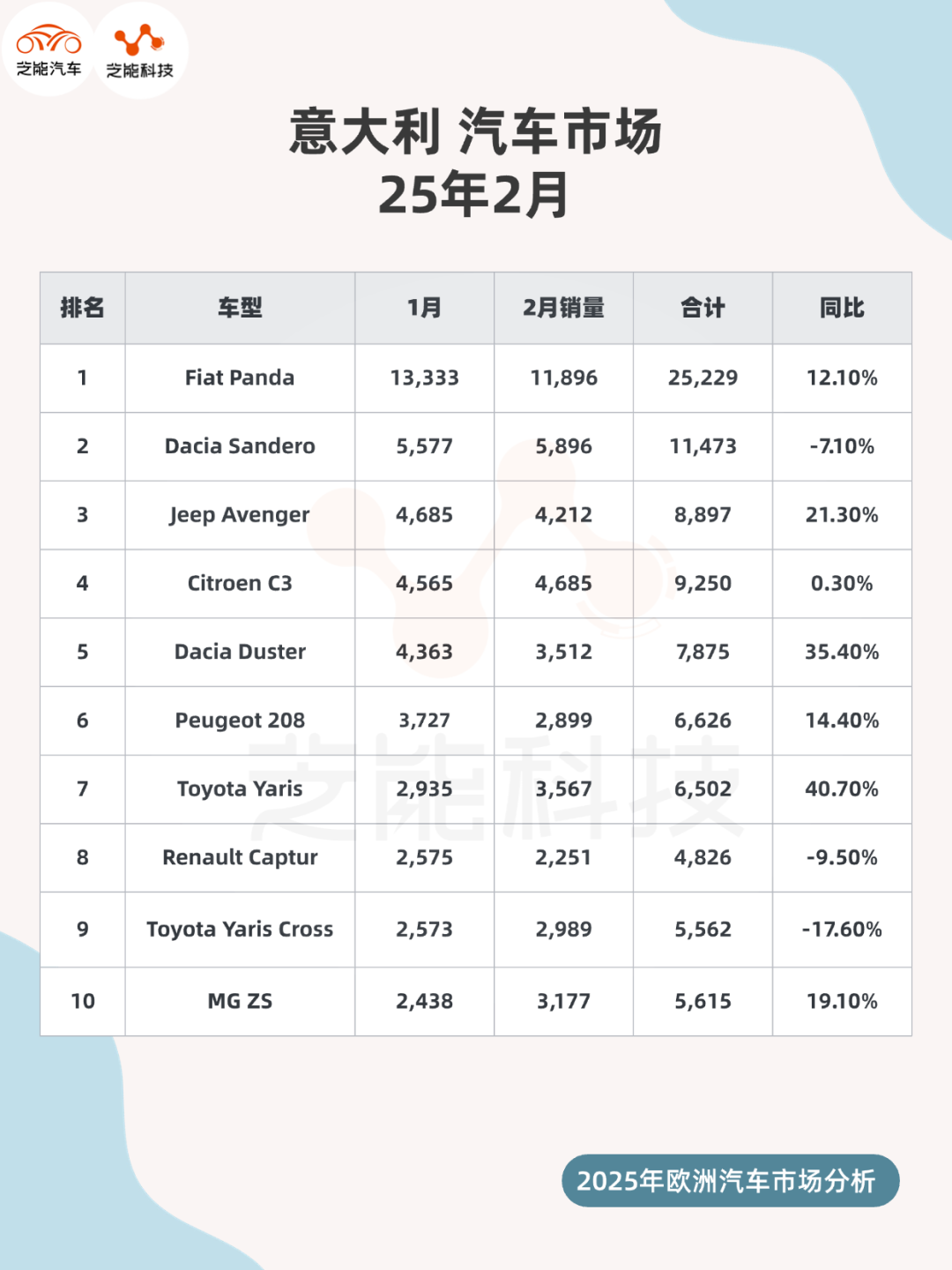European Auto Market | Italy February 2025: Navigating Change Amidst Economic Downturn
![]() 03/24 2025
03/24 2025
![]() 644
644

In 2025, the Italian auto market endured continued challenges, with sales slipping 6.1% year-on-year to 271,614 units, amid a sluggish economic recovery and dwindling consumer confidence.
● In brand sales, Fiat, the traditional leader, witnessed an 8.5% drop, its market dominance challenged by Dacia (up 12.7%) and Chinese brands such as BYD (up 1460.6%). Despite a 59.6% growth in the electric vehicle market, with a 7.2% penetration rate, Italy still lags behind the European average.
● In model sales, the Fiat Panda led with 25,229 units, yet the competitive landscape grew fiercer, with Chinese brands shining in the electric vehicle and SUV segments.
The Italian auto market is in transition, with electrification and global competition emerging as pivotal for future growth.
01
Overview of the Italian Auto Market
The Italian auto market struggled to emerge from its downturn in 2025. By February, new car registrations totaled 271,614 units, a 6.1% decrease from the previous year. While Italy's economy is forecast to grow by 1.0% in 2025 and accelerate to 1.2% in 2026, the auto market failed to capitalize on this momentum.
Inflation is anticipated to peak at 1.9% in 2025, with fluctuating energy prices and wage pressures eroding consumer purchasing power.
Italy's government fiscal deficit is projected at 3.4% of GDP, and public debt has soared to 139.3%, suppressing market confidence and demand, resulting in a sluggish recovery in 2025.

The electric vehicle market emerged as a beacon of hope in Italy's auto industry in 2025. By February, electric vehicle penetration surged 59.6% year-on-year, accounting for 7.2% of total sales. This growth was fueled by government incentives and the gradual expansion of charging infrastructure.
However, compared to other European markets, Italy's electric vehicle penetration remains low, hindered by inadequate infrastructure and limited consumer acceptance.
Traditional internal combustion engine vehicles continue to dominate, but their market share is gradually being encroached upon by electric models, signaling a shift towards electrification.
● Brand Sales
◎ Fiat led the pack with 30,654 units sold, but this marked an 8.5% decline year-on-year, putting its market leadership under threat.
◎ Dacia followed closely with 21,754 units (up 12.7%), surging ahead due to its low-price strategy and success in the electric vehicle sector.
◎ Toyota ranked third with 21,184 units (up 0.8%), maintaining stability.
◎ Volkswagen sold 18,683 units (down 2.9%).
◎ Peugeot sold 14,883 units (down 6.9%).
◎ BMW sold 12,740 units (up 3.6%).
◎ Audi sold 12,430 units (down 3.8%).
◎ Jeep sold 12,189 units (down 11.5%).
◎ Renault sold 11,978 units (down 9.7%).
◎ Citroen sold 11,909 units (down 8.4%).
Most of the top ten brands reported declines.
● Chinese brands shone brightly in the Italian market, emerging as formidable new players.
◎ BYD stood out in the electric vehicle segment, with sales soaring 1460.6% year-on-year, vaulting 21 places in the rankings.
This explosive growth is attributed to its competitive pricing, technological innovation, and keen understanding of electric vehicle demand.
◎ MG ZS sold 5,615 units (up 19.1%), ranking eighth, further solidifying its market position due to the popularity of its SUV models.
Chinese brands have swiftly gained a foothold in the Italian market through cost-effectiveness and electrification strategies.
02
Model Sales and Competitive Landscape

● In the rankings of Italy's best-selling car models in 2025
◎ The Fiat Panda retained its lead with 25,229 units sold (up 12.1%). This iconic city car maintains its dominance due to local appeal and brand loyalty, but its market share is increasingly under siege from various competitors.
◎ Dacia Sandero ranked second with 11,473 units (down 7.1%).
◎ Citroen C3 came in third with 9,250 units (up 0.3%).
Other top-selling models include:
◎ Jeep Avenger: 8,897 units (up 21.3%).
◎ Dacia Duster: 7,875 units (up 35.4%).
◎ Peugeot 208: 6,626 units (up 14.4%).
◎ Toyota Yaris: 6,502 units (up 40.7%).
◎ MG ZS: 5,615 units (up 19.1%).
◎ Toyota Yaris Cross: 5,562 units (down 17.6%).
◎ Renault Captur: 4,826 units (down 9.5%).
SUVs and compact cars remain popular in the Italian market, with the inclusion of the Chinese brand MG ZS further underscoring its competitiveness.
● The competitive landscape of the Italian auto market is undergoing significant changes.
◎ While Fiat retains its lead with the Panda model, the overall decline in sales suggests the brand's aging lineup and lack of innovation.
◎ Dacia has carved out a niche in the market through its low-price strategy and swift penetration into the electric vehicle market.
Competition in the electric vehicle sector is intensifying. Fiat's sales surged 512.3%, BYD's by 1460.6%, and Dacia's by 438.3%, while Tesla's sales dipped 44.2%, dropping out of the top five. This underscores the market's growing appetite for price sensitivity and brand diversity.
The rise of Chinese brands is a notable trend in the competitive landscape. BYD and MG ZS not only dominate the electric vehicle and SUV markets but also win over consumers through technological innovation and localized marketing strategies. European brands like Toyota and BMW maintain steady growth, while traditional powerhouses such as Volkswagen and Peugeot falter.
Summary
In 2025, the Italian auto market navigated change amidst economic downturn. Sales declines, economic pressures, and the transition to electrification coexisted, with traditional giant Fiat facing stiff competition from Dacia and Chinese brands.
The burgeoning electric vehicle market injected new life into the industry, though it will take time to achieve higher penetration rates. The meteoric rise of Chinese brands, led by BYD, significantly impacted the Italian market.







